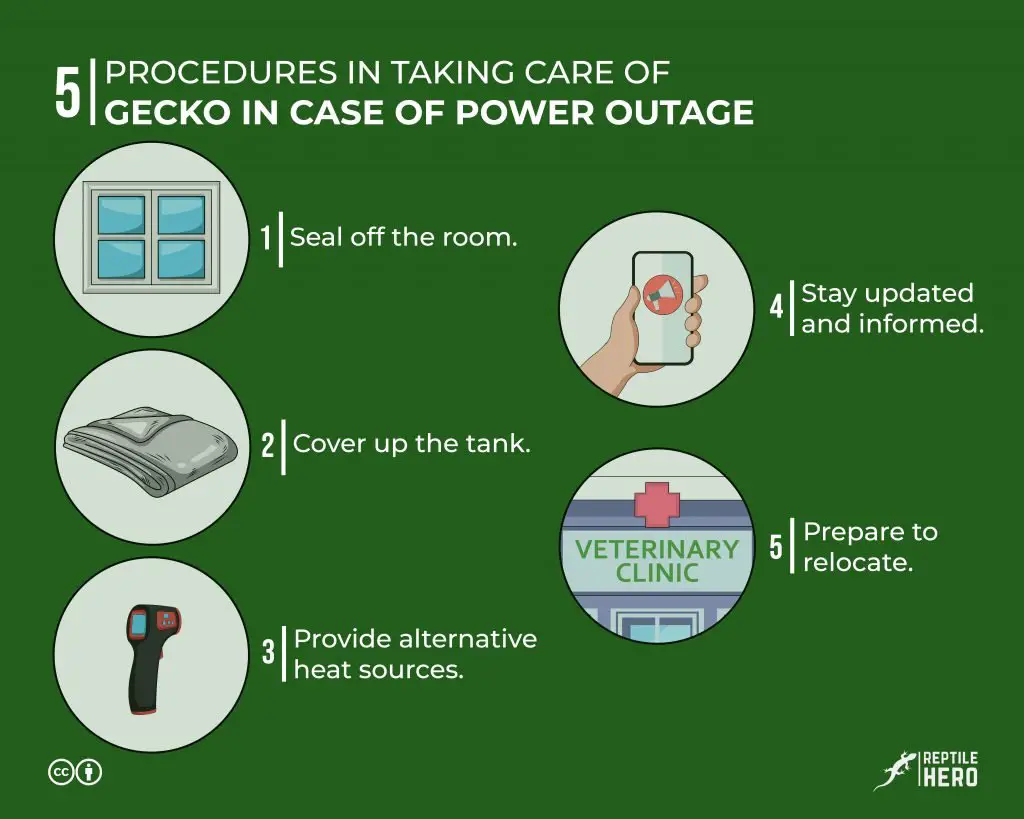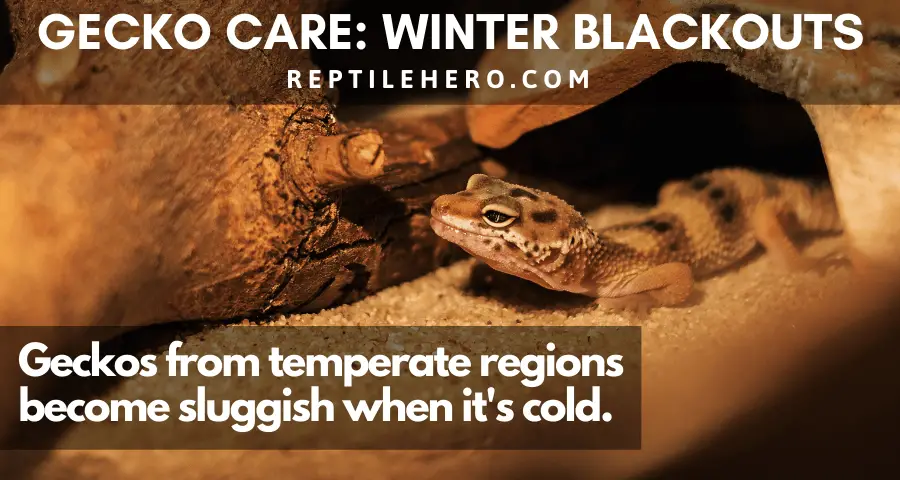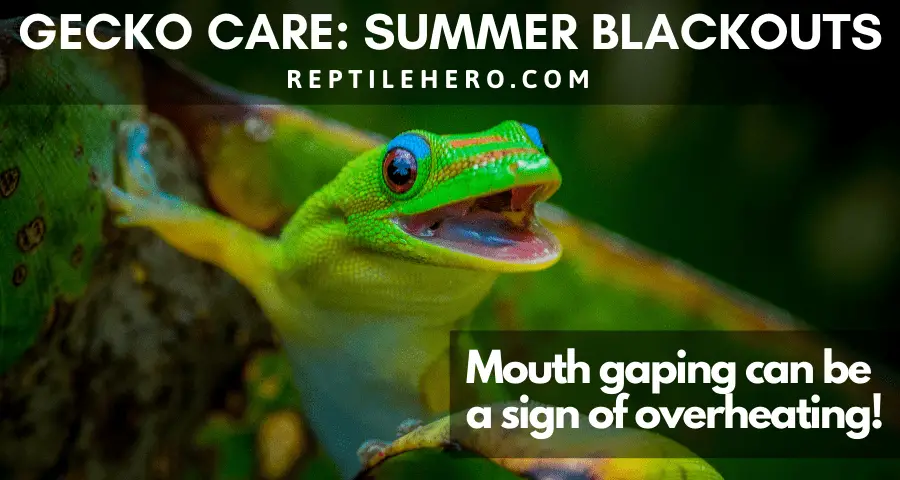Taking Care of Geckos During Power Outages [Final Guide]
Remember the horrific winter storm that happened in Texas and nearby states earlier in 2021 that caused extended periods of power outage? For the great majority of gecko owners within those areas – especially in Dallas where the temperature dropped to -2°F (-19°C) – this disaster will probably be remembered. Considering how vital heat is for geckos, is all hope lost when there’s a power outage in the dead of winter?
In general, gecko keepers must follow these 5 procedures in case of a winter power outage:
- Seal off the room.
- Cover up the tank.
- Provide alternative heat sources.
- Stay updated and informed.
- Prepare to relocate.
Conversely, for summer power outages, the caretaker must instead ensure that geckos do not overheat.
Looking for gecko-keeping tips and tricks to pick up for possible blackouts? Read on!

Gecko Care 101: Power Outages
As most gecko keepers know, owning a large collection of reptiles – geckos included – does significantly increase the electricity bill. Our cold-blooded little friends are not hard to look after, but they do need a lot of equipment that usually only run on electricity. They need heating above all things. So what is a gecko pet parent supposed to do when there’s a blackout during winter?
Winter Power Outages and Your Geckos
Geckos are ectothermic animals. They are highly reliant on external heat sources to maintain optimal body temperatures for proper physiological functioning. Lack of heating as caused by power outages during extremely cold weather could easily lead to their death.
Extreme weather events have become increasingly more common in recent years due to climate change. To combat this, people nowadays have tons of appliances and electronics at home not only for warming themselves up to avoid freezing to death, but to also make sure they stay entertained inside when it’s too cold outside to do anything.
Unfortunately, because of the continuously increasing power demands of regular consumers, small businesses, and large corporations alike, our already-strained power systems are much more likely to experience an overload. This in turn will lead to malfunctions that cause a total shut down in the electrical grid or rotating blackouts. These could last anywhere between a few hours to a few days.
So now you might be thinking, “what does all of this have to do with my pet geckos?” While for us humans, layering up on thick clothes and snuggling up under the covers is more than enough for a few hours, the same can’t be said for our cold-blooded babies. They are incapable of producing significant body heat on their own through metabolic processes unlike mammals [1].
Generally, geckos cannot survive in environments where temperatures are below 65°F (18°C) for an extended period of time. Dry and cool air can cause severe health issues which include indigestion, infections, and hypothermia.
Even though gecko species from temperate regions such as leopard geckos are able to survive during cooler months of the year through brumation, they normally do not experience any snowfall at all. For tropical species like the crested geckos which ordinarily don’t experience winter and brumation, the risk of freezing to death is heightened as drastic drops in temperatures due to the absence of consistent and ample heating experienced because of winter blackouts.
5 Practical Steps to Keep Your Gecko Warm
Aside from turning off and unplugging your home appliances for safety and saving up some water, you need to do a few things to keep your geckos warm for as long as possible. Honestly, it is incredibly challenging to keep reptiles warm enough during a long winter power outage but it is not impossible. Here are 6 easy-to-follow measures you should remember for the next time you anticipate an interruption in electrical services during the cold season.
#1 – Seal Off the Room
The very first step you should take to keep the heat in is to simply close all the windows and doors in the room your geckos’ tanks are set up in. Make sure that they are sealed tight and the warm air doesn’t escape through any gaps.
Unless your whole house – or just your reptile room alone – is well-insulated, you can expect temperatures to drop quite quickly. In such cases, seal up gaps, cracks, and holes wherever present.
You can do this with old clean pieces of cloth or go the extra mile by using duct tape.
If the sun still shows up clearly high up the skies and its light enters through your windows, don’t close your curtains. Make sure that your windows are sealed tight but let the rays enter your room through the glass to get as much heat as you could possibly get during the day.
On the other hand, if it is dark out or the sun is not visible through the clouds and snow, cover up your windows with some more blankets and then draw your curtains close.
#2 – Cover Up the Tank
After making sure that your gecko’s room is now insulated for better heat retention, the next step is to cover up your gecko’s tank as well. If you’ve got a thermal blanket in storage for emergencies, it’s time to bust them out.
Completely wrap up the sides of your gecko’s vivarium with a blanket and/or other insulating materials to slow down heat loss. Only cover 1/2 or 2/3 of the mesh top to allow for some ventilation and prevent suffocation.
If the walls and ceiling are made of solid panels and your only access point is the front swinging or sliding door, slightly open that and have at least 1 inch across the topmost portion in front uncovered. You need to reduce the speed of heat loss but you also don’t want to totally cover up their tanks and cut off airflow.
Now, I know that not everybody keeps a thermal blanket at home. If you don’t have it, fret not. A thick blanket, quilt, or towel would suffice. You could even use clean shirts or sweaters to insulate your tank.
Other materials you can also make use of include aluminum foil, polystyrene foam sheets (more commonly referred to as styrofoam), cork panels, polyethylene films, as well as bubble wrap. All of these can be wrapped around your gecko’s enclosure to keep the heat in for as long as possible. You use these in layers too, depending on your situation.
#3 – Provide Alternative Heat Sources

To reiterate, geckos native to temperate countries are more able to weather through low temperature levels. Leopard geckos, for instance, usually stay within the confines of the rock outcroppings in dry grasslands for the duration of winter to brumate [2]. Brumation is a period of dormancy for geckos and other reptiles. They mostly stay asleep, conserving the fat reserves they have saved up during the rest of the year.
At times, they may wake up to drink some water and stay hydrated. Keep in mind, they can last longer without food than without water. So during winter power outages, it is important to make sure that all geckos stay hydrated with room temperature water (73°F or 23°C) and don’t force them to eat. Geckos will not be able to digest food properly when temperatures are lower than optimal.
Keep an infrared thermometer gun (here is a good one on Amazon) by the tank so that it is within reach at all times. Having this enables you to check on your gecko’s body temperature and the ambient temperature within its tank without repeatedly opening and closing its enclosure.
Ready-to-Use Gecko Heating Solutions During Power Outages
These readily available products will help your gecko stay warm during winter power outages:
- Non-toxic unscented candles
- Indoor gas-powered space heater
- Hand warmers
- Chemical heat packs
- Hot water bottles
It is important to take note of whether or not the product you are planning to use is safe to use within closed doors to avoid carbon monoxide poisoning as well as possible house fires. None of these should be in direct contact with your pet’s skin or placed inside their vivarium – even the heat packs made specifically for transporting animals like reptiles (here on Amazon).
Never used a chemical warmer for shipping animals and plants before? Here is a quick run-down on how to use for :
In cases where you have none of the aforementioned items, it is important for people to have a few tricks up their sleeves to keep their reptiles warm.
DIY Gecko Heating Solutions During Power Outages
Improvised heating solutions you can use to keep geckos and other ectothermic animals warm:
- Sock heating pods. If you’ve got rice or even pebbles, heat them up (place them under direct sunlight indoors close to your windowsill) and store them in a thick sock. Place this in the warm side of your gecko’s enclosure. However, this won’t last all day long. You may need to do this a couple of times throughout the day.
- DIY space heaters. Light up a couple of small or one medium candle and place it under a ceramic or terracotta pot. Prop up the pot with two bricks or cups. If you’re out of candles but have cans of vegetable shortening, you can stick a strip of cardboard or wick into it and use that instead.
- Baking sheet heat pad. Heat up a metal baking sheet and wrap at least one thick towel around it. You can place it on the warm side of your gecko’s tank, by the floor or wall. This will also lose heat after a few hours.
- Makeshift hot water bottles. If you don’t have those rubber hot water bottles, you can make your own using recycled and cleaned plastic bottles, juice containers, and milk jugs. Boil some water and simply transfer it into the container. Wrap some cloth around it for safe contact.
- Share your body heat. On the off-chance that your water and heating source runs out, consider helping your gecko stay warm using your own body heat. If your gecko has no issues with handling and isn’t jumpy, you can let them stay in the pocket of your hoodie. For fussy geckos, you can place them in deli cups with air holes and hold them close to your body.
As long as you have a gas-powered stove, non-electric fireplace, wood-burning stove, or anything else you can start a fire with, you can do something to keep your gecko warm and cozy. Sharing your body heat should only be the last resort because doing so will require taking your gecko out of its familiar home environment.
Lastly, I do not recommend you placing your gecko right on top of your skin because we normally have body temperatures within the 98-100°F (36.5-37.5°C) range and this is like laying your gecko right on top of a heat pack. They may suffer from burns. I have even come across posts of geckos having a patch of their skin melt due to prolonged direct contact with their owner’s skin.
#4 – Stay Updated and Informed
It can be challenging to stay online and keep up with the latest news and announcements for the situation in your area when your home internet connection (Wi-Fi network) only works when your and your service provider both have electricity.
Of course, this isn’t always possible and you need to look for other ways to stay connected.
There are five ways to communicate with others and receive announcements that work without electricity, so they are great during a power outage:
- Mobile data. Most people would probably have mobile or cellular data as their sole source and medium for communication. You can directly check government and news websites for accurate and real-time updates. However, unless you have countless power banks at your disposal, your phone will inevitably lose power.
- AM/FM portable radio. Having at least one battery-powered or rechargeable AM/FM radio is necessary for staying on top of things. This also prevents you from being reliant on your phone alone. You can listen to the news as it airs, all the while maximizing your phone’s battery life. There are also hand-crank models available.
- Ham radio. Although a great choice for maintaining communication during times of emergency, ham or amateur radios can be overwhelming for most people. You will need to attend classes or undergo training to know how to operate one. Nevertheless, it has proven to be indispensable in numerous disasters and power outages in the US.
- Corded landline phone. Otherwise known as fixed-line telephones, is one of the most reliable means of communication despite being old-fashioned. This can still run even when there are power failures in your county or when cell towers go dark. Publicly available phone booths also use this, so keep a couple of change around with you.
- Satellite phone. Unlike all the previous methods of getting in contact with others, a satellite phone, or satphone, will work in worst-case scenarios when power, cell towers, and phone lines are all destroyed. Regardless of your location, this will work since it relays calls and short text messages via the satellites circling the Earth.
In any event, it’s important to keep tabs on how long the power interruption will last along with many other things – weather reports and forecasts, boil water notice, etc.
#5 – Prepare to Relocate
Once the ambient temperature in your house begins to drop into the 50°F (10°C) range and you no longer have alternative heat and/or water sources, consider relocating to a place with power.
Call up friends and family nearby to know if you can temporarily stay with them. You could also look up nearby exotic veterinary clinics and animal sanctuaries to see whether or not they can provide shelter for your gecko (and other pets) for you until your power is back on. They usually have generators for emergencies since they care for tons of animals.
Warm up your car while you are preparing for the move. Set your car’s heating system up to get to about 65°F (18°C) before setting your gecko housed in its small temporary plastic carrier inside the vehicle.
It is not advisable to travel with your gecko while it is housed in its full-sized, decked-out tank. A simple plastic food container with air vents soldered to the side, lined with a few sheets of paper towel at the bottom will do.
After moving to a place with electricity and heating, do not feed the gecko for at least 24 hours. Doing so ensures that your baby has ample time to slowly raise its body temperature to a point where its physiological activities can function properly again.
Summer Power Outages and Your Geckos

For blackouts caused by high winds during the summer hurricane season, you can follow the gecko-care guide for a winter power outage. On the opposite end of the spectrum, another major problem for pet parents is keeping geckos cool enough during a summer power outage.
The average gecko cannot survive in environments where temperatures are above 90°F (32°C) for an extended period of time. Being housed in a habitat with constantly high temperatures will result in hyperthermia or overheating.
Symptoms of hyperthermia for geckos may include:
- Mouth gaping
- Abnormal breathing
- Refusal of food
- Uncoordinated movements
- Decreased droppings
- Unresponsiveness
If your gecko displays any of the previously mentioned behaviors, immediately provide clean room temperature water for them to drink and move their enclosure to a cooler room in the house. Then call up your local exotic veterinarian and set up an appointment for the soonest time slot available.
How to Keep a Gecko Cool?
Here are 5 ways to keep a gecko cool in case of high ambient temperature (such as during a summer power outage):
- Get hot air out. Open up your windows and curtains to maximize airflow in the house. If your gecko’s tank will be exposed to direct sunlight, keep the window open but pull your curtains down.
- Wet towels lower temperatures. Drape damp towels directly outside the cold side of your gecko’s enclosure. You could also set it on top of a rechargeable fan to help lower the ambient temperature in the whole room. You will need to moisten this repeatedly as the water evaporates.
- Use ice and frozen items. Take out a handful of ice from your fridge – it will take a long time for frozen items to completely thaw out even due to blackouts. Place it in a zip-lock plastic bag and wrap a towel around that. Keep it inside the tank, by the wall of the cool side. You could also place it directly on the ceiling if it has a mesh top. If you have reusable ice blocks (here on Amazon), those would last much longer.
- Let it rain. Keep misting within the vivarium using cool water (approximately 68°F or 20°C). Just make sure not to aim directly at your precious little gecko.
- Cool up from the bottom. If you have a naturalistic set-up with a soil-mix type of substrate, moisten half of it (cool side) with cool water. Remember: do moisten, don’t drench. This will encourage your gecko to burrow into the vivarium bedding to thermoregulate more efficiently.
To repeat, you need your infrared thermometer gun with you – at all times if possible – so you can easily monitor your gecko’s body temperature and the temperature within its tank.
3 Precautionary Measures to Consider for Power Outages
As you might have realized, dealing with a blackout as it happens is incredibly difficult. So hopefully, you are reading this in preparation for possible power interruptions and you have enough time to consider other things which I haven’t already mentioned earlier in this article.
Even if you think it might not happen anytime in the near future, I recommend that you plan way ahead of time for possible emergencies – not only blackouts but other disasters too. It’s always better to be proactive than simply being reactive, especially when you have geckos in your care. So here are the three top things you should look into.
#1 – Emergency Gecko-Care Kit
Stock up on the necessary supplies you will need for your emergency gecko-care kit. Unlike emergency go-bags for humans and our fur-babies that you can easily buy from physical and online stores, custom-made kits for reptiles aren’t really a thing. It should be good for at least 3 full days since emergencies are quite unpredictable.
A 72-hour emergency gecko-care kit should have the following things:
- First-aid kit
- Freeze-dried insects
- Water
- Reptile-safe travel heat packs
- Rechargeable handheld fans (here on Amazon)
- Hand towels
- Hand sanitizer and/or alcohol
- Non-toxic cleansing wipes
- A pack of extra paper towels
- Infrared thermometer gun
- Small plastic carrier/temporary housing (here on Amazon)
If you have a large family of reptiles, make sure to make enough emergency kits for each one. It’s also fairly easy to customize the contents of such kits. Feel free to add things you think are necessary for your specific reptile babies.
#2 – Invest in Power Sources for Emergencies
Investing in alternative sources for power to use during emergencies may seem like overdoing things for many beginner gecko owners. However, many regular keepers and professional breeders actually say that it is essential considering how uncertain the future is as a result of climate change among other things.
Here are a few alternative power sources you should consider investing in:
- Gas-powered portable generator
- Uninterruptible Power Supply (UPS) system
- Power inverter for car batteries
- Portable power station
- Battery-powered outlets/power strip
Take your power consumption into consideration when selecting which models to buy. Also, please make sure to carefully read the manuals and follow instructions for operating such products.
#3 – Switch to a Better Vivarium Set-up
Depending on where you are staying, you might have to reconsider your gecko’s current tank set-up. If you experience all four seasons, with heavy snowfall during winter, switch to a vivarium primarily made from treated non-toxic wood materials.
On the other hand, if the summer heat is the bane of your existence as a gecko-keeper, opt for glass or PVC. Giving them a naturalistic or bio-active set-up also encourages them to engage in normal thermoregulating activities such as burrowing and seeking moist humid spaces.
Either way, you should check out the enclosures offered by Zen Habitats. They come in a variety of sizes and styles. You can even reach out to them for help in creating a practical but beautiful reptile room perfect for housing different types of geckos and other reptiles or amphibians.
Takeaways
During a winter power outage, 1) seal off your reptile room, 2) cover up your gecko tanks, 3) provide alternative heat sources, 4) stay updated and informed, and lastly, 5) prepare to relocate if necessary.
When an interruption of electrical services happens during the summer, your geckos are at risk of suffering from heatstroke. As such, you must help them maintain an optimal temperature gradient with a cool side.
Precautionary measures for gecko-keeping during emergencies include: 1) having an emergency kit for each of your geckos, 2) investing in alternative power systems, and 3) changing your tank set-up to suit your specific circumstances.
Sources
[1] https://www.sciencedirect.com/topics/earth-and-planetary-sciences/thermoregulation


![Can You Train Your Gecko? [5 Tricks It Can Learn Now]](https://www.reptilehero.com/wp-content/uploads/2021/02/Gecko-Training-Infographic-768x614.jpg)
![Do Geckos Eat Their Own Poop? [The Science of Coprophagia]](https://www.reptilehero.com/wp-content/uploads/2021/08/Gecko-eat-poop-cc-1-768x614.jpg)
![Do Leopard Geckos Like Blankets? [Best Fabrics]](https://www.reptilehero.com/wp-content/uploads/2021/05/word-image-768x576.png)


